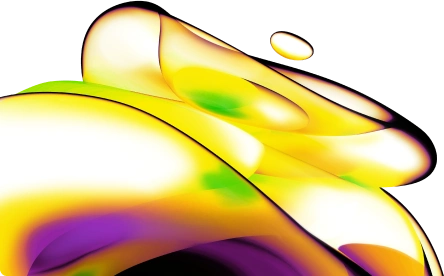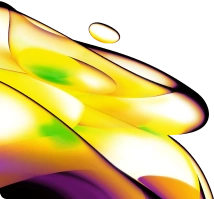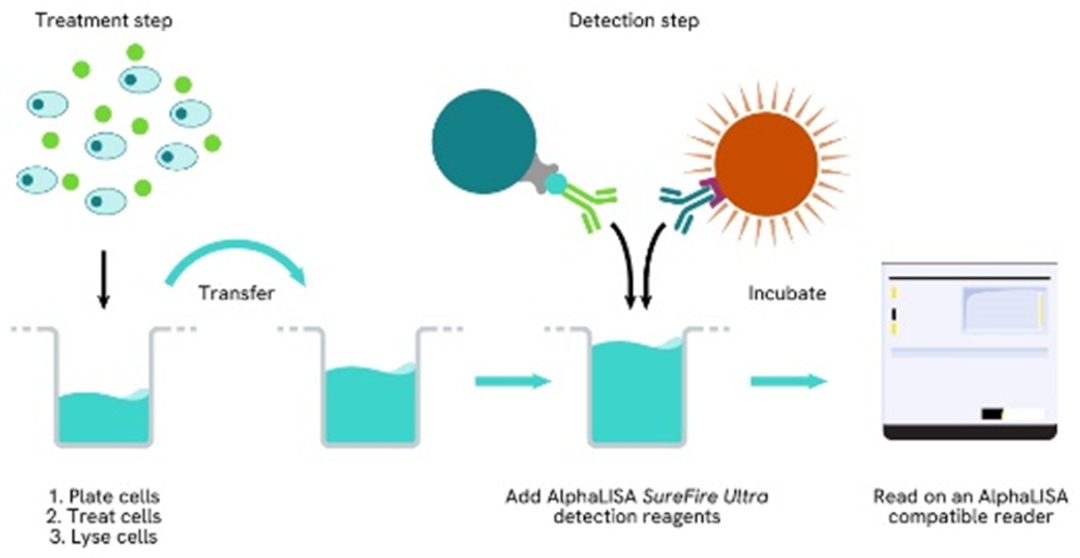

AlphaLISA SureFire Ultra Human Total Cyclin E1 Detection Kit, 500 Assay Points
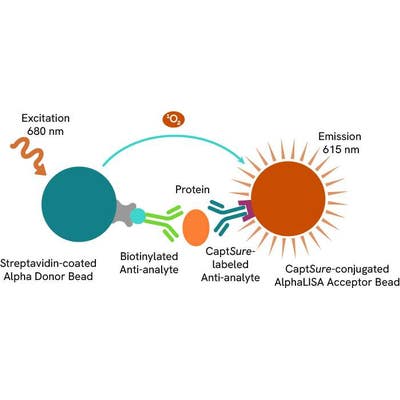

 View All
View All
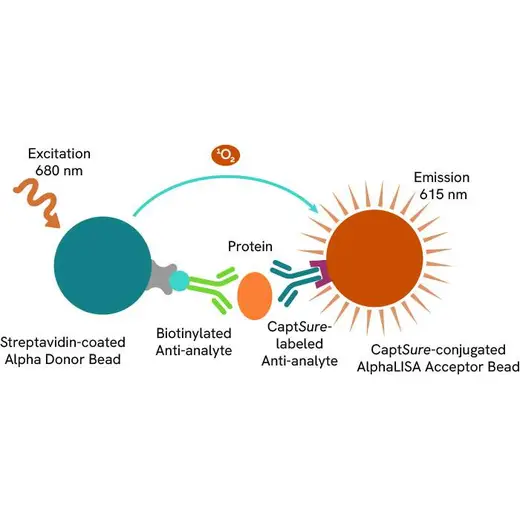









| Feature | Specification |
|---|---|
| Application | Cell Signaling |
| Sample Volume | 10 µL |















Product information
Overview
Cyclin E1 (CCNE1) is a member of the highly conserved cyclin family, whose members have various roles in the cell cycle. CCNE1 forms a complex with cyclin-dependent kinase 2 (CDK2) and acts as a regulatory subunit. CDK2 is required for cell cycle G1/S transition. Overexpression of CCNE1 has been observed in many tumors, such as breast, ovarian, endometrial, and bladder cancer.
The AlphaLISA SureFire Human Total Cyclin E1 Detection Kit is a sandwich immunoassay for the quantitative detection of total Cyclin E1 in cellular lysates, using Alpha Technology.
Formats
- The HV (high volume) kit contains reagents to run 100 wells in 96-well format, using a 60 μL reaction volume.
- The 500-point kit contains enough reagents to run 500 wells in 384-well format, using a 20 μL reaction volume.
- The 10,000-point kit contains enough reagents to run 10,000 wells in 384-well format, using a 20 μL reaction volume.
- The 50,000-point kit contains enough reagents to run 50,000 wells in 384-well format, using a 20 μL reaction volume.
AlphaLISA SureFire Ultra kits are compatible with
- Cell and tissue lysates
- Antibody modulators
- Biotherapeutic antibodies
Alpha SureFire kits can be used for
- Cellular kinase assays
- Receptor activation studies
- Screening
How it works
Total-AlphaLISA SureFire Ultra assay principle
The Total-AlphaLISA SureFire Ultra assay measures the expression level of a protein target in a cell lysate.
The Total-AlphaLISA SureFire Ultra assay uses two antibodies which recognize two different distal epitopes on the targeted protein. AlphaLISA assays require two bead types: Acceptor and Donor beads. Acceptor beads are coated with a proprietary CaptSure™ agent to specifically immobilize the assay specific antibody, labeled with a CaptSure tag. Donor beads are coated with streptavidin to capture one of the detection antibodies, which is biotinylated. In the presence of targeted protein, the two antibodies bring the Donor and Acceptor beads in close proximity whereby the singlet oxygen transfers energy to excite the Acceptor bead, allowing the generation of a luminescent Alpha signal. The amount of light emission is directly proportional to the quantity of protein present in the sample.
Total-AlphaLISA SureFire Ultra two-plate assay protocol
The two-plate protocol involves culturing and treating the cells in a 96-well plate before lysis, then transferring lysates into a 384-well OptiPlate™ plate before the addition of Total-AlphaLISA SureFire Ultra detection reagents. This protocol permits the cells viability and confluence to be monitored. In addition, lysates from a single well can be used to measure multiple targets.

Total-AlphaLISA SureFire Ultra one-plate assay protocol
Detection of Total target protein with AlphaLISA SureFire Ultra reagents can be performed in a single plate used for culturing, treatment, and lysis. No washing steps are required. This HTS designed protocol allows for miniaturization while maintaining AlphaLISA SureFire Ultra quality.
Assay validation
Hydroxyurea induction of Cyclin E1
A549 cells were seeded in a 96-well plate (20,000 cells/well) in complete medium, and incubated for 24 hours at 37°C, 5% CO2. Cells were treated with increasing concentrations of Hydroxyurea for 18 hours.
After treatment, the cells were lysed with 100 µL of Lysis Buffer for 10 minutes at RT with shaking (350 rpm). Phospho (Thr77) and Total Cyclin E1 levels were evaluated using respective AlphaLISA SureFire Ultra assays. For the detection step, 10 µL of cell lysate (approximately 4,000 cells) was transferred into a 384-well white OptiPlate, followed by 5 µL of Acceptor mix and incubated for 1 hour at RT. Finally, 5 µL of Donor mix was then added to each well and incubated for 1 hour at RT in the dark. The plate was read on an Envision using standard AlphaLISA settings.
As expected, Hydroxyurea treatment resulted in a dose-dependent increase in the levels of Phospho (Thr77) and Total Cyclin E1.

Upregulation of Cyclin E1 by Neuregulin-1
MCF7 cells were seeded in a 96-well plate (40,000 cells/well) in complete medium, and incubated for 24 hours at 37°C, 5% CO2. Cells were treated with 20 µM wortmannin for 3 hours and then increasing concentrations of Neuregulin-1 for 24 hours in serum free medium.
After treatment, the cells were lysed with 100 µL of Lysis Buffer for 10 minutes at RT with shaking (350 rpm). Total Cyclin E1, Phospho (Thr160) and Total CDK2 levels were evaluated using respective AlphaLISA SureFire Ultra assays. For the detection step, 10 µL of cell lysate (approximately 4,000 cells) was transferred into a 384-well white OptiPlate, followed by 5 µL of Acceptor mix and incubated for 1 hour at RT. Finally, 5 µL of Donor mix was then added to each well and incubated for 1 hour at RT in the dark. The plate was read on an Envision using standard AlphaLISA settings.
As expected, Neuregulin-1 treatment resulted in a dose-dependent increase in Cyclin E1 levels as well as activation of other cell cycle regulators.
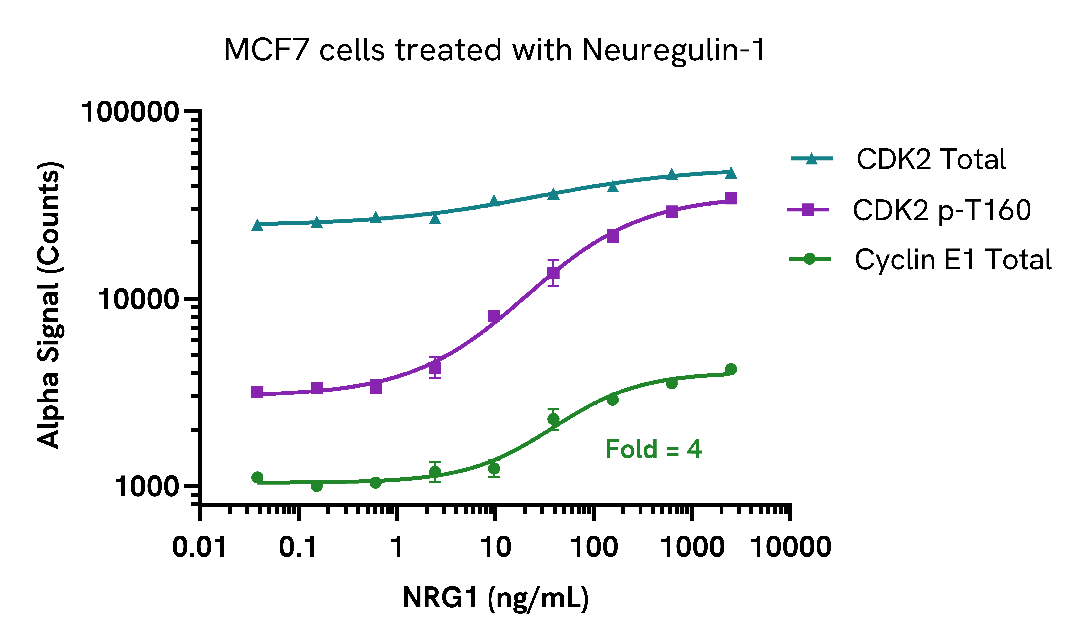
Decrease in Cyclin E1 levels induced by Nocodazole
A549 cells were seeded in a 96-well plate (20,000 cells/well) in complete medium, and incubated for 24 hours at 37°C, 5% CO2. Cells were treated with increasing concentrations of Nocodazole for 18 hours.
After treatment, the cells were lysed with 100 µL of Lysis Buffer for 10 minutes at RT with shaking (350 rpm). Phospho (Thr77) and Total Cyclin E1 levels were evaluated using respective AlphaLISA SureFire Ultra assays. For the detection step, 10 µL of cell lysate (approximately 4,000 cells) was transferred into a 384-well white OptiPlate, followed by 5 µL of Acceptor mix and incubated for 1 hour at RT. Finally, 5 µL of Donor mix was then added to each well and incubated for 1 hour at RT in the dark. The plate was read on an Envision using standard AlphaLISA settings.
As expected, Nocodazole treatment induced a dose dependent decrease in the levels of Phospho (Thr77) and Total Cyclin E1.
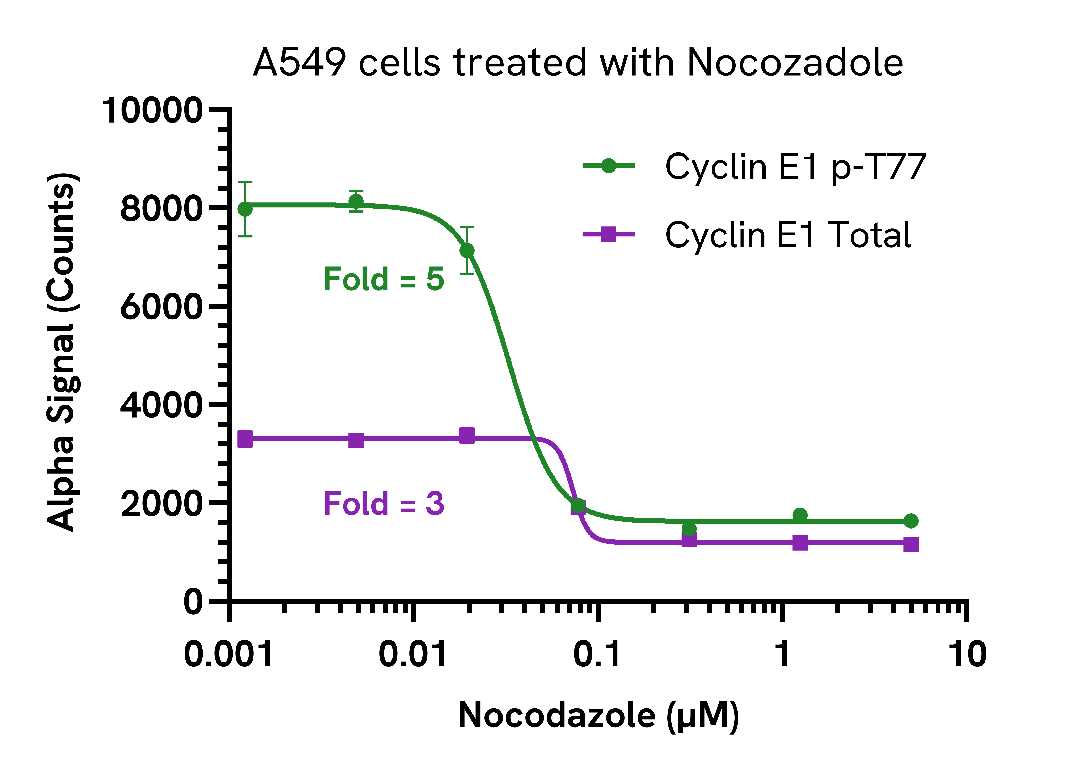
A431 cells were seeded in a 96-well plate (50,000 cells/well) in complete medium and incubated for 24 hours at 37°C, 5% CO2. Cells were treated with increasing concentrations of Nocodazole for 18 hours.
After treatment, the cells were lysed with 100 µL of Lysis Buffer for 10 minutes at RT with shaking (350 rpm). Levels of Cyclin E1 and Cofilin were evaluated using respective AlphaLISA SureFire Ultra assays. For the detection step, 10 µL of cell lysate (approximately 10,000 cells) was transferred into a 384-well white OptiPlate, followed by 5 µL of Acceptor mix and incubated for 1 hour at RT. Finally, 5 µL of Donor mix was then added to each well and incubated for 1 hour at RT in the dark. The plate was read on an Envision using standard AlphaLISA settings.
As expected, Nocodazole treatment induced a dose dependent decrease in the levels of Cyclin E1 with no changes in the levels of Cofilin.
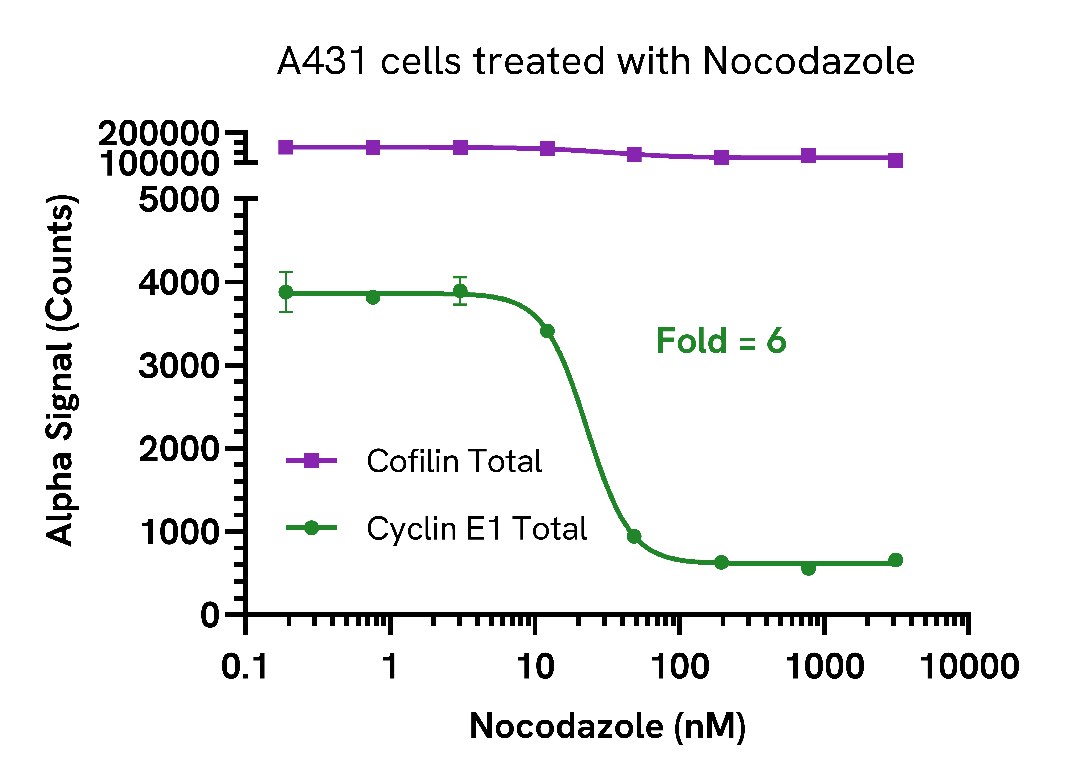
Assay versatility
Versatility of Total Cyclin E1 assay in various cell lines
Adherent cells were seeded at 20,000 cells/well in a 96-well culture plate in complete medium and incubated overnight at 37°C, 5% CO2. Cells were lysed with 100 µL of Lysis Buffer.
Cyclin E1 levels were evaluated by AlphaLISA SureFire Ultra. For the detection step, 10 µL of cell lysate (approximately 2,000 cells) was transferred into a 384-well white OptiPlate, followed by 5 µL of Acceptor Mix and incubated for 1 hour at RT. Finally, 5 µL of Donor Mix was then added to each well and incubated for 1 hour at RT in the dark. The plate was read on an Envision using standard AlphaLISA settings.
As expected, Cyclin E1 is expressed at high levels in BeWo cells.
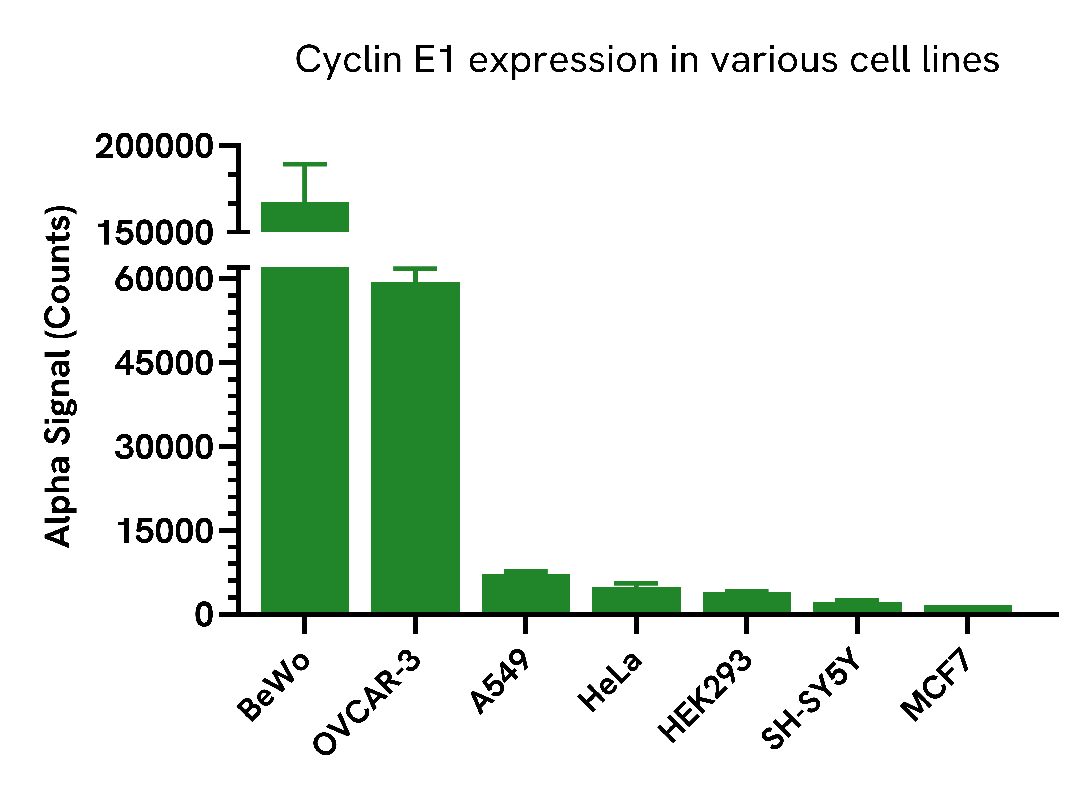
Specifications
| Application |
Cell Signaling
|
|---|---|
| Automation Compatible |
Yes
|
| Brand |
AlphaLISA SureFire Ultra
|
| Detection Modality |
Alpha
|
| Lysis Buffer Compatibility |
Lysis Buffer
|
| Molecular Modification |
Total
|
| Product Group |
Kit
|
| Sample Volume |
10 µL
|
| Shipping Conditions |
Shipped in Blue Ice
|
| Target |
Cyclin E1
|
| Target Class |
Phosphoproteins
|
| Target Species |
Human
|
| Technology |
Alpha
|
| Therapeutic Area |
Oncology
|
| Unit Size |
500 assay points
|
Video gallery









Resources
Are you looking for resources, click on the resource type to explore further.
The measurement of protein phosphorylation is a useful tool for measuring the modulation of receptor activation by both antibodies...


Loading...
How can we help you?
We are here to answer your questions.
